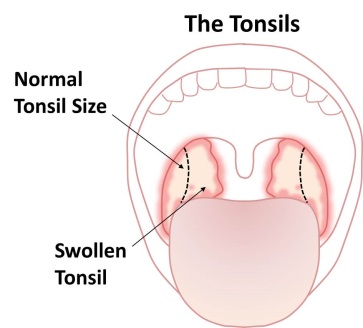Frequent sore throat can occur in children for a number of reasons
Virus infections
Young children are prone to virus infections because their immune systems are immature and developing. Pre-school children are also exposed to each other’s coughs, colds and sore throats.
Virus infections can cause pharyngitis (redness at the back of the throat), or tonsillitis (redness and swelling of the lumps on either side of the throat).
Infections usually settle down within 3 to 5 days. Simple painkillers, salt water gargles, and encouraging fluids are usually the only treatment required.
Antibiotics are not normally given as they are ineffective against viruses, can cause side effects like diarrhea, and excessive use of antibiotics diminishes their effectiveness when they are needed for more serious conditions.
Bacterial infections
Bacteria such as Streptococcus can also cause pharyngitis and tonsillitis in children.
Signs that tonsillitis is caused by bacterial rather than viral infection are a high temperature, white pus-filled spots on the tonsils, no cough, and swollen tender neck glands.
If bacterial tonsillitis is suspected then antibiotics may be prescribed. A swab can be used to help confirm the diagnosis but will take a few days to get the result.
In particularly severe cases or if your child cannot eat or drink then admission to hospital may be needed for intravenous antibiotics and fluids (through the vein).
Nasal allergies and sinus infections
Allergies can cause throat irritation. Stuffy noses result in mouth breathing which can also produce dry, sore throat. Infection of the nose and sinus can also drain mucous down into the throat, carrying infection with it.
Gastroesophageal reflux (GERD)
GERD is a condition in which acid from the stomach backflows into the throat. It may require a change in dietary habits or sometimes medication to control it.
Environmental irritants
Environmental irritants such as pollution or cigarette smoke can also cause recurrent throat problems.
Does my child need a tonsillectomy?
Tonsillectomy is the surgical removal of the tonsils. In most cases, tonsillectomy is recommended only if your child meets certain criteria:
- Your child’s sore throat is due to tonsillitis (other causes listed above may need to be excluded)
- Episodes are disabling and prevent normal functioning (causing missed school days)
- There should be five or more episodes in each of the preceding two years
- Or three or more episodes in each of the preceding three years
What happens during tonsillectomy?
Tonsillectomy is carried out under general anesthetic, meaning your child is asleep during the procedure. The anesthetist passes a special breathing tube. Your child’s mouth will be held open and the tonsils are removed through the mouth. No cuts are made in the skin.
The operation can be carried out in a number of ways as described below.
- Cold dissection – a surgical blade is used to cut the tonsils out. Bleeding is controlled by applying pressure or sealing the blood vessels using heat generated by diathermy.
- Diathermy – an electrical probe is used to cut through tissue and seal the blood vessels at the same time.
- Coblation (or cold ablation) – this method works in a similar way to diathermy but uses a lower temperature (60C). It’s considered less painful than diathermy.
- Lasers – high energy laser beams are used to cut away the tonsils or shrink them.
Dr. Lau is experienced in each of these techniques and will advise you. Your child will usually be able to leave hospital on the same day as surgery or the day after.
Related Media Coverage:
How should I look after my child following tonsillectomy?
Advanced ENT Centre
6 Napier Road, #07-16 Gleneagles Medical Centre
Singapore 258499
(Opposite Singapore Botanic Gardens)
Telephone number: +65 6471 1031
Fix An Appointment Send Us Email
24 HOUR EMERGENCY NUMBER : 96610139


